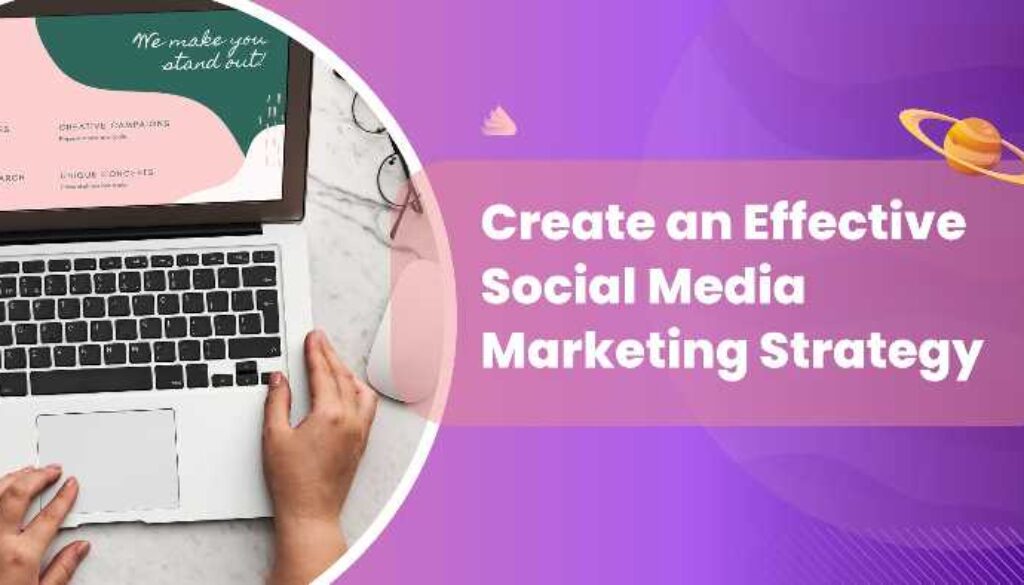Effective Social Media Marketing Strategy
Table of Contents
How to Create an Effective Social Media Marketing Strategy?
In today’s digital world, social media has become an essential tool for businesses. From small local shops to large companies, everyone is using social media platforms like Facebook, Instagram, Twitter, and LinkedIn to connect with people, promote their products, and build relationships with customers. But, to use social media effectively, a business needs a good plan. This plan is called a social media marketing strategy.
In this blog, we’ll go over what a social media marketing strategy is, why it’s important, and how you can create one for your business step-by-step. If you’re thinking about a career in this field, you can consider enrolling in Digital Marketing courses in Pune to learn these skills in-depth. These courses are available at various Digital Marketing training institutes, which also offers placement to help students start their careers.
What is a Social Media Marketing Strategy?
A social media marketing strategy is a plan for using social media to achieve your business goals. It helps you know what to post, when to post, and who to reach with your posts. Instead of just posting random things, a strategy gives you a clear direction so that every post has a purpose.
When done right, a social media marketing strategy can help you:
- Increase brand awareness – let more people know about your business
- Connect with your audience
- Build trust with your customers
- Drive traffic to your website
- Increase sales
Creating a social media strategy might sound complicated, but it doesn’t have to be. Follow these simple steps to make a strategy that works for your business:
Step 1: Set Your Goals
The first step in creating a social media marketing strategy is to define your goals. Ask yourself, “What do I want to achieve with social media?” Different businesses have different goals. For example:
A small clothing store may want to increase brand awareness to let more people know about their products, or a service-based business like a Digital Marketing training institute in Pune might want to drive more people to sign up for their courses.
Here are some common social media goals to consider:
- Increase brand awareness: Get more people to know about your business.
- Generate leads and sales: Encourage people to buy your products or services.
- Drive traffic to your website: Get people to visit your website for more information.
- Build a community: Connect with your audience and keep them engaged.
- Provide customer support: Answer questions and solve problems for customers.
Make sure your goals are specific and measurable. For example, instead of saying “I want more followers,” say “I want to increase followers by 20% in 3 months.”
Step 2: Know Your Audience
Knowing who your audience is will help you create content that interests them. Audience research is about finding out who your ideal customers are.
Think about details like:
- Age: How old are they?
- Location: Where are they from?
- Interests: What are their hobbies or interests?
- Social media platforms: Where do they spend most of their time? (Facebook, Instagram, LinkedIn, etc.)
For example, if you’re promoting a Digital Marketing Training Institute in Pune, you may want to target students or professionals aged 18–35 who are interested in digital marketing. Knowing your audience’s age, interests, and preferred social media platform helps you create content that resonates with them.
Step 3: Choose the Right Platforms
Not every platform is suitable for every business. Choose platforms where your audience is most active. Here’s a quick look at some popular platforms and their main uses:
- Facebook: Great for sharing updates, events, and connecting with a wide audience.
- Instagram: Best for visual content like photos and videos, popular with younger audiences.
- Twitter: Useful for quick updates and connecting with people in real-time.
- LinkedIn: Ideal for professionals and B2B connections.
- YouTube: Great for sharing educational videos, tutorials, and product demos.
You can choose from above platforms based on you target audience. For example, if your target audience is young and active on Instagram, focus on Instagram. If you’re targeting professionals, LinkedIn is a good choice.
Also Read: How To Prepare a Social Media Calendar?
Step 4: Create Quality Content
Your content is what people see and interact with on social media, so it needs to be good! Different types of content work well on social media, such as:
- Images: Show products, team members, or events.
- Videos: Share behind-the-scenes clips, tutorials, or customer testimonials.
- Blog posts and articles: Share helpful information and drive traffic to your website.
- Infographics: Use images to explain data or processes in a simple way.
- Polls and Q&A: Engage your audience and get feedback.
For example, if you’re running a Digital Marketing training institute in Pune, you could share short videos explaining basic digital marketing concepts, testimonials from past students, or updates about new courses. Good content gives people a reason to follow your page and engage with your posts.
Step 5: Schedule Your Posts
Consistency is key in social media. Posting regularly keeps your audience engaged and reminds them of your brand. But it can be hard to post every day, so many businesses use tools like Buffer, Hootsuite, or Facebook Creator Studio to schedule posts in advance. This saves time and ensures your content goes live when your audience is active.
Some basic posting frequency guidelines:
- Facebook and Instagram: Post 3–4 times per week.
- Twitter: Post daily or multiple times per day.
- LinkedIn: Post 1–2 times per week.
Choose a schedule that works for you and stick to it. Experiment with posting times to see when your audience is most active and responsive.
Step 6: Engage with Your Audience
Social media is a two-way street. It’s important to engage with your audience by replying to comments, answering questions, and responding to messages. Engagement builds trust and shows that you care about your customers.
Here are a few ways to increase engagement:
- Respond to comments and messages quickly.
- Like and reply to people who tag your brand.
- Run polls and ask questions to encourage interaction.
- Share user-generated content like customer photos or testimonials.
For instance, if someone leaves a comment asking about the benefits of enrolling in Digital Marketing courses in Pune, respond with helpful information and a link to your website for more details.
Step 7: Analyze Your Results
To know if your social media strategy is working, you need to track your results. Social media platforms provide insights that show how well your posts are doing. Look at metrics like:
- Engagement rate: How many people liked, commented, or shared your posts.
- Reach: How many people saw your posts.
- Click-through rate: How many people clicked on links in your posts.
- Follower growth: How many new followers you gained.
Regularly reviewing these metrics helps you understand what’s working and what isn’t. If a particular type of post gets a lot of engagement, you can create more of that content in the future.
Step 8: Adjust Your Strategy
Based on the data you gather, make changes to your strategy. Social media trends are always evolving, so it’s important to stay flexible. If a platform introduces new features or your audience’s preferences change, be ready to adjust your content and approach.
For example, if you find that most of your followers are engaging with video content, you might want to focus more on creating videos. Experimenting and learning from your results is the best way to improve over time.
Conclusion
Creating an effective social media marketing strategy can help your business grow, reach new audiences, and build stronger relationships with customers. Remember, a good strategy includes setting clear goals, knowing your audience, creating valuable content, engaging with followers, and regularly checking your results.
If you’re interested in learning more about social media marketing and digital marketing strategies, consider enrolling in a Digital Marketing training institute in Pune. One such institute is Victorious Digital that offer hands-on training, and even provide digital marketing courses in Pune with placement assistance. This way, you’ll gain the skills and experience needed to start a successful career in digital marketing.
Social media is a powerful tool when used with a clear strategy, so start planning today, stay consistent, and watch your business grow!




